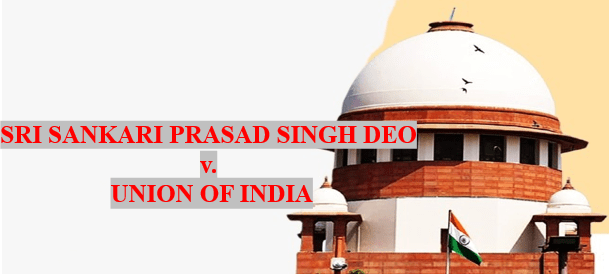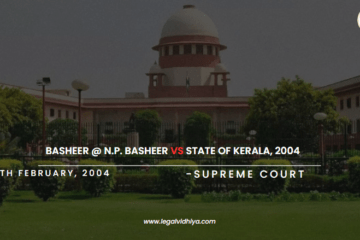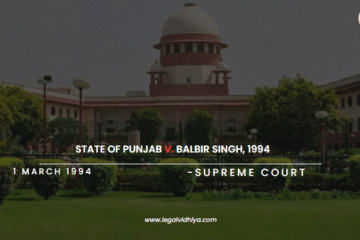
SRI SANKARI PRASAD SINGH DEO v. UNION OF INDIA
| Case Name | Sri Sankari Prasad Singh Deo v. Union of India |
| Equivalent Citations | AIR 1951 SC 458, 1951 SCR 89 |
| Date of Judgement | 5 October 1951 |
| Court | Hon’ble Supreme Court of India |
| Petitioner | Sri Sankari Prasad Singh Deo |
| Respondent | Union of India and State of Bihar(other cases) |
| Bench | Hon’ble Chief Justice J.Hiralal Kania, Hon’ble M. Patanjali Sastri, Hon’ble B.K. Mukherjee, Hon’ble Sudhi Ranjan Das, Hon’ble N. Chandrasekhara Aiyar |
| Referred | Articles 13(2), 31-A, 31-B,32,132,368,379,392 of the Constitution of India |
FACTS OF THE CASE
The landmark judgement challenged the first constitutional amendment of 1951. The Constitution (First Amendment) Act of 1951 made it possible to impose restrictions on free speech and expression, legalise zamindari abolition legislation, and make it clear that the right to equality does not preclude the passing of laws that provide “special consideration” to society’s weaker groups. With the Zamindari Abolition Act, The zamindars felt aggrieved and opposed the law because they believed it violated their fundamental right. With this amendment, the Parliament introduced Articles 31-A and 31-B to the Indian Constitution as well as the Ninth Schedule, which safeguards the land reform and other legislation included therein from judicial scrutiny. This indicates that the Ninth Schedule was included so that any topic covered by it cannot be contested in any Indian court and is not susceptible to judicial review. In a writ petition submitted to the Supreme Court according to Article 32[4] of the constitution, the zamindars questioned whether the First Amendment Act, 1951, approved by the Parliament, was invalid and unconstitutional. This matter was brought before a constitutional bench of the supreme court, where the court was primarily confronted with three problems.
ISSUES RAISED
- Whether the amendment was constitutionally valid?
- Can the legislation make amendments to the Fundamental Rights enshrined in the Constitution?
- Whether the Constituent laws fall under the concept of “law” in Article 13(2)?
ARGUMENTS
The Petitioners contended that under Article 368, the power to amend the Constitution is conferred upon both the houses of Parliament, thus does not extend to the provisional Parliament that was present in this case, further backed by Article 379. The authority granted by Article 368 requires the joint action of both Houses of Parliament and may only be properly exercised by the Parliament that will be duly constituted in accordance with Ch. 2 of Part V of the Indian Constitution. In so far as it attempts to amend Article 368 by omitting “either House of” and “in each House” and substituting “Parliament” for “that House,” Order No. 2 issued by the President on January 26th, 1950, exceeds the authority granted to him by Article 392 because “any difficulties” sought to be removed by adaptation under that article must be difficulties in the actual functioning of the Constitution during the transitional period whose removal is necessary for carrying on the Government. Such an issue could not reasonably have existed on the day the Constitution first took effect. Since Article 368 is a complete code in and of itself, a Bill cannot be modified after it has been introduced in the House. Since the statement in the current instance was allegedly altered in a number of particular throughout its passage through the House, the Amendment Act cannot be considered to have been approved in accordance with the procedure established in Article 368. Further the Petitioners argue that the Act is inconsistent with the rights promised in Part III of the Constitution, falling within the prohibitions established via Article 13(2). Articles 132 and 136 in Chapter IV of Part V and Article 226 in Chapter V of Part VI are changed by the newly introduced articles 31A and 3lB, which are invalid and unconstitutional. They are also ultra vires since they deal with items on List II, over which the State legislatures, not Parliament, have the authority to enact legislation.
The Respondent contended that if the petitioner’s claim that Article 368 is inapplicable to the interim parliament because it refers to “two houses” is upheld, it might defeat the whole intent of Article 379. They further emphasised on the fact that it is incorrect to perceive that Article 368 is a complete code in itself as procedural irregularities continue to exist.
JUDGEMENT
After considering all the relevant facts and circumstances, the Court emphasised the distinction between ordinary and constituent laws. Constitutional laws are primarily concerned with establishing the executive, legislative, and judicial branches of government, dividing governmental authority among them, and delineating their interrelationships. In order to protect them from state-made legislation that can interfere with them, some Fundamental Rights were inserted. These rights are also protected from constitutional amendments. On the other hand, the provisions of Article 368 are completely generic and provide Parliament with absolute authority to change the Constitution. It would have been very simple to include a provision to that effect if it had been intended to protect the fundamental rights from the application of that clause. In essence, the two articles are both broadly worded yet operate in opposition to one another. Because amendments to the Constitution made in the exercise of constituent authority are not considered “law” in the meaning of Article 13 and instead refer to rules or regulations, article 13(2) does not apply to amendments made by Article 368. The supplementary claim that the additional articles could not have been passed by Parliament is also unpersuasive. They were purportedly connected to the area that was covered by item 18 of List II of the Seventh Schedule and that the State legislatures alone had the authority to enact laws in that regard. The response is because, as was already indicated, articles 31A and 31B aim to protect specific laws and classes of laws that have already been approved from the combined effects of article 13 read in conjunction with the other relevant articles of Part III. Since the additional articles were effectively amendments to the Constitution, only Parliament had the authority to enact them. The fact that the laws are related to subjects on List II does not change the situation.
The first Constitutional (Amendment) Act, 1951, was upheld by the court in this way, and the petitions were dismissed with costs. The Supreme Court narrowed the scope of Article 13(2), adopting the position of an Independent Nation through property acquisition.
CONCLUSION
A landmark case in the truest sense, the case dealt with the tussle between Article 13(2) and Article 368- whether the structure remains absolutely flexible or certain checks and balances should be imposed to protect the basic structure of the Constitution. The crux and the judgement of this case was challenged and questioned various times eventually leading up to the judgements of Golaknath v. State of Punjab and later, explored in Kesavananda Bharti v. Union of India.As a result, the following arguments and ruling greatly aided in the development and comprehension of Article 368 regarding relevant provisions. It is clear that the Sankari Prasad Singh Deo v. UOI case significantly impacted how the Constitution was interpreted and the notion of the fundamental structure was developed, both of which serve to uphold the Constitution of India’s spirit.
CITATIONS
- Sri Sankari Prasad vs Union of India- https://indiankanoon.org/doc/1706770/
- Sri Sankari Prasad v. Union of India, 1951AIR 458, 1952 SCR 89- https://www.scconline.com/
This case analysis is written by- Kavya Tiwari, intern under Legal Vidhiya.




0 Comments